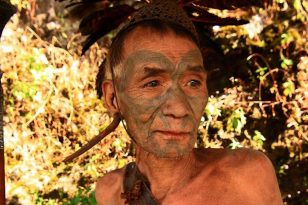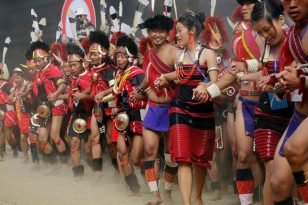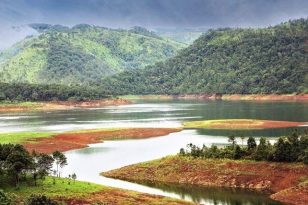The land of the warrior race of the Naga people is tucked away in the far end of North-East India, sharing international boundary with Myanmar. Nagaland is well known for its legend of the fearsome headhunting tribes. Up until the 19th century, the practice of headhunting was still prevalent more out of pride and glory in battles than for bounty or rewards. The entry of Christian missionaries swept in an overwhelming cultural transformation, showing the exit door to several customs, including headhunting and animism. Sixteen different tribes in this dominantly hilly state, with their own unique traditions and languages, find common ground through the Nagamese language and a fierce warrior tradition of yore.
Kohima
Kohima is the capital city of Nagaland is about 74 km or a drive of 2 hours from Dimapur Airport. Home to the Angami Nagas and the Rengma Nagas, the original name of this city was ‘Kewhira,’ It was later changed by the British colonial rulers, as they couldn’t pronounce it correctly. As the second biggest urban and economic centre in Nagaland, Kohima opens up a wide range of activities for visitors. The Kohima cathedral is the largest in Asia and stands tall in the town. From trekking on the undulating hills to gulping on the local delicacies, Kohima gives you the perfect taste of the Naga Culture. The Kohima Zoo houses the Blythe’s Tragopan, Hornbill (the state bird) and the Mithun (the state animal). The Kohima museum gives the tourists a detailed idea of the rare Naga arte-facts. Other interesting places to visit include Bara Basti (the second largest village in Asia), Kohima War Cemetery and the Naga Bazaar. The meat market in the Naga Bazaar is quite a scene to see, and the faint hearted are suggested not to visit there. Nagaland is known for the exquisite range of meats that the eateries serve here. Pork, beef, lamb, chicken, mutton etc are some of the most favored varieties.
Mon
About 360 kms from Kohima, lies the town of Mon, which finds mention due to the true ethnic Naga experience it gives. Home to the largest tribe of the state, the Konyak Nagas, Mon still exhibits traces of the infamous headhunting tradition of Nagaland. It was this place where the greatest warriors lived, followed by hereditary chieftains known as Anghs. Hence, every Angh’s house has skulls decorated at the entrance, with a décor comprising of skulls, elephant tusks and hornbill beaks and beautiful woodwork filling the insides. Face tattoos can still be seen in a sizeable number of Konyaks, who are skilled in making machetes, guns, headgear, necklaces and so on. The town of Mon was historically established as a site for the coronation of the Anghs. Every year in the first week of April, the whole town comes alive with the festival of Aoling Monyu to close the previous year’s winter and welcome the New Year with the beginning of spring. You will see males dressed in richly designed shawls and feathered headgear doing the warrior dance with machetes and spears in the hands. Another attraction is the Longwa village who’s Angh(chief) has half of his house on Indian and the other half in Myanmar. Veda is the highest peak in Mon which opens up a brilliant view of the Brahmaputra and Chindwin Rivers.
Dzukou Valley
This incredibly beautiful valley is at a distance of about 30 kms from Kohima, the capital of Nagaland. The beauty of the Dzukou Valley had made it one of the most popular trekking destinations in the entire North-East India. Lying at a height of 2438 meters and spread across the two sates of Nagaland and Manipur behind the Japfu Peak (of Nagaland), Dzukou is definitely a sight to savor. The name Dzukou literally translates to cold water in ‘Angami’ and ‘Mao’ dialects (local dialects of Nagaland) because the stream that flows through the valley freezes during winter. As a trekker’s paradise, Dzükou Valley attracts hordes of campers and bird watchers every year. The natural caves and the big rocks add up to the valley’s appeal. The best time to visit is between June and September when a blanket of wild flowers spread out over the entire valley making the valley resemble a paradise. It is, in fact, the only place where the rare breed of lily (named as Dzükou lily) and rhododendrons of varied colors are found.
Touphema
Touphema, situated about 40 km from Kohima, is the official tourist village of Nagaland. Some say it is a village set up exclusively to give the tourists a taste of the rural life in Nagaland. Touphema is the best place to experience the traditional Naga lifestyle at its authentic best. The most striking feature of Touphema is the assortment of wooden huts closely stacked up next to each other with each house having a unique thematic character. Each of them is outlined with intricate woodwork, spears, machetes, wooden stars and anything that speaks of the traditional Naga culture. The incredible landscape of the valleys down below from the hilltop is serene. Touphema offers the tourists traditional antiquity among modern amenities. The evening with bonfire meals and cultural performances is a soothing thing to do. Local Naga delicacies like pork with bamboo shoot and bamboo baked fish accompanied by rice beer (local brew) are always the main attraction. The annual festival of Angami Sekrenyi celebrated by the Angami Nagas in February is an event worth experiencing.
Khonoma
Most of Nagaland is pretty much green, but the greenest of all the places is the 700 year-old village of Khonoma. It has been possible only because of the people’s awareness towards environment conservation. Located in a distance of 20 km west of Kohima, Khonoma is largely made up of the Angami Naga population, who has displayed a high degree of environmental consciousness. More than anything, it was an effort to preserve the population of the Blythe’s Tragopan. Cutting of forests and hunting is strictly prohibited here. Hence, a varied range of rare and endangered species of birds, plants and animals have made the green village a popular biodiversity destination for nature lovers. The Khonoma Nature Conservation and Tragopan Sacntuary which was set up in 1998 is a major tourist attraction. Spread across 70 sq km, the sanctuary hosts scores of tourists to its biological extravaganza, becoming a major contribution to the rise of ecotourism in the village. The ride to Khonoma from Kohima may be bumpy and neck jolting, but the ordeal is worth it once you reach there.
Dibrugarh
Dibrugarh, the ‘tea city of India’ was the bastion of the Ahom dynasty during the Ahom-Sutiya war. It is quite possible the town got its name from Dibarumukh where the Ahoms were camped. Another theory is the construction of a fort on the banks of the Dibaru River when the British came to occupy [Dibaru + Garh (fort)] it. Dibrugarh’s economy primarily depends on tea gardens, oil and timber industries. Lately, Dibrugarh has grown considerably because of ongoing projects like Brahmaputra Cracker and Polymer Limited and the longest railroad bridge Bogibeel. Ahoms are the dominant community here and majorly responsible for the production of woodwork, including cane and bamboo furniture, Assam silk, gamosa (traditional headscarf/hand towel) and mekhela chador (traditional silk wraparound of the Assamese women). Dibrugarh boasts of several tourist attractions, but the most significant are the Dibru Saikhowa National Park, The Dehing Patkai rainforest, Barbarua Maidam, Koli Aai Thaan, Namphake Village and Dehing Namti Satra.
Tours

Sekrenyi Festival Tour
The tour takes you to the state of Nagaland during the Sekrenyi festival of the Angami tribe and further into remote Nagaland to meet the last of the headhunting Konyak Nagas.
Price: £ 2350

Aoling Festival of the Tattooed Headhunting Tribes of Nagaland
The tour takes you to the state of Nagaland during the Aoling festival of the headhunting tattooed tribe of the Konyak Nagas in the remote district of Mon. Here, visit Lungwa, where the village chief's house sits amidst the India-Burmese border and other villages and get the opportunity to meet the village elders who wear tattoos on their faces and torso, wear animal hair and skin and headdress.
Price: £ 2250

The Eagle’s Nest Tour
This is an amazing 15-day tour that will take you to Eagle’s Nest along the Indo – Bhutan border, considered to be one of the top birding destinations in the world.
Price: £ 1950

Hornbill Festival Tour
In this trip, visit India’s North East during the Hornbill Festival, where each of the 16 Naga tribes (belonging to the state of Nagaland) showcases its colourful costumes with beads, jewellery, ivory armlets, headgears (made of bamboo, orchids and decorated with boar’s teeth and hornbill’s feathers) and weapons (spears and daos).
Price: £ 2350

15 days North East India tour: Living Root bridges, Rhinos, Tea & Tribes
In this tour you will visit the North East Indian states of Assam. Meghalaya and Nagaland. The tour begins in Guwahati, the gateway to North East India and also the most important commercial centre of the region.
Price: £ 2450
